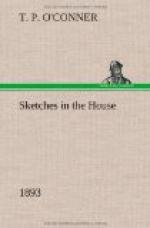Colonel Saunderson—another of the Orange army of fire-eaters—was early at the trysting-place; and this brought about one of the curiosities of the sitting. On the first seat below the gangway sat Dr. Tanner; on the very next seat, as close to him as one sardine to another in a box, sat Colonel Saunderson. Not for worlds would these two men exchange a syllable; indeed, it was a relief to most people to find that they did not break out into oaths and blows. What rendered the situation worse, was that Dr. Tanner has a fine exuberant habit of expressing his opinions for the benefit of all around him. At his back sat William O’Brien, with his keen thin face, his eyes full of latent fire, his stern, set jaw—his glasses suggesting the student and philosopher, who is always the most perilous and fierce of politicians; and to William O’Brien, Tanner made a running and biting commentary on the speeches—a commentary, as can easily be guessed, from the extreme National point of view. This was the music to which the Orange Colonel had to listen through the long hours that stretched between his early morning arrival and midnight. How men will consent to go through all this travail is, to easy-going people, one of the curiosities of political struggle.
[Sidenote: The Chamberlain Party.]
Meantime, there had been another and an equally important descent. Mr. Chamberlain made his son the Whip of the Unionist Party. The resemblance between father and son is something even closer than that usually noticed between relatives. The son looks a good deal more gentlemanly than the father. But the single eyeglass—which no man can wear without looking more or less of a snob—is even less becoming to the youthful Austen than to the parent; and gives him even a coarser air. There is a suspicion that young Chamberlain also came to the House armed with a goodly supply of hats; at all events, he and his friends managed to secure a large number of seats for the Unionists. Chamberlain and his friends sat together on the third bench below the gangway—a position of ’vantage in some respects—from which they could survey the House. The first seat was occupied by Mr. Chamberlain; next him was Sir Henry James, and then came Mr. Courtney, in a snuff-coloured coat and drab waistcoat; for all the world like an old-fashioned squire who has not yet learned to accommodate himself to the sombre garments of an unpicturesque age. The dutiful Austen left himself without a seat, and was content to kneel in the gangway, and there take sweet counsel from his parent.
[Sidenote: Enter the G.O.M.]




